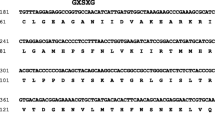Abstract
Adipose triglyceride lipase (ATGL) is an important triglyceride-specific lipase that catalyzes the initial step in triglyceride hydrolysis. In this study, cloning, sequencing, and mRNA real-time analyses were employed to characterize the chicken ATGL gene. We obtained a total of 1,528-bp long chicken ATGL cDNA fragment including 51-bp 5′UTR, 1,452-bp open reading frame (ORF), and 25-bp 3′UTR. The predicted chicken ATGL had 483 amino acids and a molecular weight of 53.5 kDa, giving rise to identities of 66.5%, 67.3%, 68.2%, 64.8%, and 66.5% with that of human, mouse, rat, pig, and cattle, respectively. The chicken ATGL gene spanned over 30,197 bp and comprised of nine exons and eight introns, in which the intron 1 (21,146 bp) was far longer than others. It predominantly expressed in subcutaneous fat and abdominal fat and then in kidney and lung. Very low but detectable mRNA level was also observed in other 15 tissues. However, no mRNA was detected in spleen. A total of 15 single nucleotide polymorphisms (SNPs) were identified in its complete cDNA sequences with an average of one SNP in every 102 bp and a summarized nucleotide diversity of 3.02 × 10−3. Seven of the 15 SNPs were non-synonymous. All SNPs had allelic frequencies over 5% and could be considered as candidate markers for future marker-trait association analysis.




Similar content being viewed by others
References
Raben DM, Baldassare JJ (2005) A new lipase in regulating lipid mobilization: hormone-sensitive lipase is not alone. Trends Endocrinol Metab 16:35–36. doi:10.1016/j.tem.2005.01.009
Wang SP, Laurin N, Himms-Hagen J, Rudnicki MA, Levy E, Robert MF et al (2001) The adipose tissue phenotype of hormone-sensitive lipase deficiency in mice. Obes Res 9:119–128. doi:10.1038/oby.2001.15
Okazaki H, Osuga J, Tamura Y, Yahagi N, Tomita S, Shionoiri F et al (2002) Lipolysis in the absence of hormone-sensitive lipase: evidence for a common mechanism regulating distinct lipases. Diabetes 51:3368–3375. doi:10.2337/diabetes.51.12.3368
Haemmerle G, Zimmermann R, Hayn M, Theussl C, Waeg G, Wagner E et al (2002) Hormone-sensitive lipase deficiency in mice causes diglyceride accumulation in adipose tissue, muscle, and testis. J Biol Chem 277:4806–4815. doi:10.1074/jbc.M110355200
Fredrikson G, Strålfors P, Nilsson NO, Belfrage P (1981) Hormone-sensitive lipase of rat adipose tissue. Purification and some properties. J Biol Chem 256:6311–6320
Zimmermann R, Strauss JG, Haemmerle G, Schoiswohl G, Birner-Gruenberger R, Riederer M et al (2004) Fat mobilization in adipose tissue is promoted by adipose triglyceride lipase. Science 306:1383–1386. doi:10.1126/science.1100747
Jenkins CM, Mancuso DJ, Yan W, Sims HF, Gibson B, Gross RW (2004) Identification, cloning, expression, and purification of three novel human calcium-independent phospholipase A2 family members possessing triacylglycerol lipase and acylglycerol transacylase activities. J Biol Chem 279:48968–48975. doi:10.1074/jbc.M407841200
Villena JA, Roy S, Sarkadi-Nagy E, Kim KH, Sul HS (2004) Desnutrin, an adipocyte gene encoding a novel patatin domain-containing protein, is induced by fasting and glucocorticoids: ectopic expression of desnutrin increases triglyceride hydrolysis. J Biol Chem 279:47066–47075. doi:10.1074/jbc.M403855200
Smirnova E, Goldberg EB, Makarova KS, Lin L, Brown WJ, Jackson CL (2006) ATGL has a key role in lipid droplet/adiposome degradation in mammalian cells. EMBO Rep 7:106–113. doi:10.1038/sj.embor.7400559
Haemmerle G, Lass A, Zimmermann R, Gorkiewicz G, Meyer C, Rozman J et al (2006) Defective lipolysis and altered energy metabolism in mice lacking adipose triglyceride lipase. Science 312:734–737. doi:10.1126/science.1123965
Schoenborn V, Heid IM, Vollmert C, Lingenhel A, Adams TD, Hopkins PN et al (2006) The ATGL gene is associated with free fatty acids, triglycerides, and type 2 diabetes. Diabetes 55:1270–1275. doi:10.2337/db05-1498
Fischer J, Lefèvre C, Morava E, Mussini JM, Laforêt P, Negre-Salvayre A et al (2007) The gene encoding adipose triglyceride lipase (PNPLA2) is mutated in neutral lipid storage disease with myopathy. Nat Genet 39:28–30. doi:10.1038/ng1951
Akiyama M, Sakai K, Ogawa M, McMillan JR, Sawamura D, Shimizu H (2007) Novel duplication mutation in the patatin domain of adipose triglyceride lipase (PNPLA2) in neutral lipid storage disease with severe myopathy. Muscle Nerve 36:856–859. doi:10.1002/mus.20869
Chen JF, Dai LH, Xu NY, Xiong YZ, Jiang SW (2006) Assignment of the patatin-like phospholipase domain containing 2 gene (PNPLA2) to porcine chromosome 2p17 with radiation hybrids. Cytogenet Genome Res 112:342G. doi:10.1159/000089897
Deiuliis JA, Shin J, Bae D, Azain MJ, Barb R, Lee K (2008) Developmental, hormonal, and nutritional regulation of porcine adipose triglyceride lipase (ATGL). Lipids 43:215–225. doi:10.1007/s11745-007-3146-1
Shan T, Wang Y, Wu T, Guo J, Liu J, Feng J et al (2008) Porcine adipose triglyceride lipase gene clone, expression pattern and regulation by resveratrol. J Anim Sci (Apr):11; Epub ahead of print
Cargill M, Altshuler D, Ireland J, Sklar P, Ardlie K, Patil N et al (1999) Characterization of single-nucleotide polymorphisms in coding regions of human genes. Nat Genet 22:231–238. doi:10.1038/10290
Cooper DA, Stein JC, Strieleman PJ, Bensadoun A (1989) Avian adipose lipoprotein lipase: cDNA sequence and reciprocal regulation of mRNA levels in adipose and heart. Biochim Biophys Acta 1008:92–101
Fendri A, Frikha F, Mosbah H, Miled N, Zouari N, Bacha AB et al (2006) Biochemical characterization, cloning, and molecular modelling of chicken pancreatic lipase. Arch Biochem Biophys 451:149–159. doi:10.1016/j.abb.2006.04.018
Nie Q, Lei M, Ouyang J, Zeng H, Yang G, Zhang X (2005) Identification and characterization of SNP in 12 chicken growth-correlated genes by DHPLC. Genet Sel Evol 37:339–360. doi:10.1051/gse:2005005
Acknowledgments
This work was funded by Major State Basic Research Development Program, China (project no. 2006CB102100) and the National Natural Science Foundation of China (project no. 30600429). We would like to thank Dr. Jianlin Han (Chinese Academy of Agricultural Sciences, China) for his helpful comments on this article.
Author information
Authors and Affiliations
Corresponding author
Rights and permissions
About this article
Cite this article
Nie, Q., Fang, M., Xie, L. et al. cDNA cloning, characterization, and variation analysis of chicken adipose triglyceride lipase (ATGL) gene. Mol Cell Biochem 320, 67–74 (2009). https://doi.org/10.1007/s11010-008-9899-x
Received:
Accepted:
Published:
Issue Date:
DOI: https://doi.org/10.1007/s11010-008-9899-x




